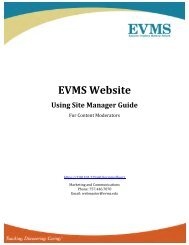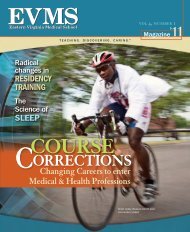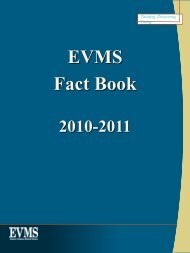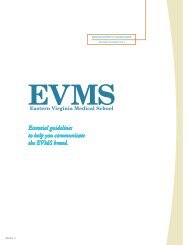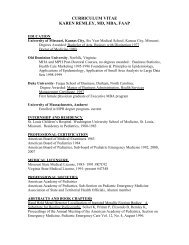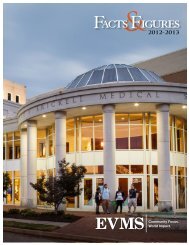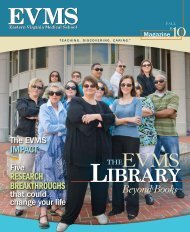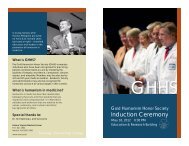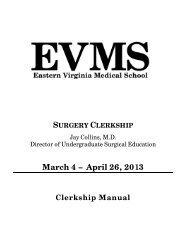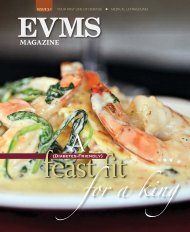Name change reflectsart therapist’s role as counselorPencil, paper, pa<strong>in</strong>tbrushes and model<strong>in</strong>g claycan be powerful tools for help<strong>in</strong>g people of allages overcome the limitations of their mental andphysical conditions.For decades the <strong>Eastern</strong> Virg<strong>in</strong>ia <strong>Medical</strong> SchoolGraduate Art Therapy and Counsel<strong>in</strong>g Programhas prepared students to do just that.“We teach people to use art materials — any andall type — with their clients,” said program directorAbby Calisch, PsyD, AT. Clients can <strong>in</strong>clude anyonefrom children to older adults, with problemsfrom psychological to medical to behavioral tocommunication disorders.Started <strong>in</strong> 1973, the EVMS program recentlyamended its name to more properly reflect whatit does. With the possible exception of a longerletterhead, the change from Art Therapy to ArtTherapy and Counsel<strong>in</strong>g won’t mean a lot ofadjustments. Add<strong>in</strong>g the word “counsel<strong>in</strong>g” wasma<strong>in</strong>ly a housekeep<strong>in</strong>g change, Dr. Calisch says,s<strong>in</strong>ce the program already prepared students to gettheir professional therapist license.“There’s a movement <strong>in</strong> the profession ofalign<strong>in</strong>g coursework for students to becomelicensed professional therapists, and not hav<strong>in</strong>gthe word counsel<strong>in</strong>g <strong>in</strong> the title was an issue <strong>in</strong>some states,” she says.What hasn’t changed is the program’s missionto prepare students to help their clients throughart. For example, a therapist might work with adepressed person by us<strong>in</strong>g a variety of art materialsto stimulate different parts of the bra<strong>in</strong>.“The person on their ownmay choose dark, restrictivematerial, such as us<strong>in</strong>g darkpencils <strong>in</strong> small areas, and thetherapist might work withthem to <strong>in</strong>crease activity andmovement with bright colorsor larger media,” Dr. Calischsays. “On the opposite endof the spectrum, for a childwith Attention DeficitHyperactivity Disorder, thetherapist might help themfocus by conta<strong>in</strong><strong>in</strong>g themwith boundaries and limits.”Like t heir medic a lcolleagues, therapists use awide palette of options to helpclients.“Different art materials,like medications, can work ondifferent parts of the bra<strong>in</strong>. The materials have theirown personalities,” Dr. Calisch says. “We’re just nowbecom<strong>in</strong>g able to show, through high-resolutionbra<strong>in</strong> scans, that this works. It’s not merely fluff.”The two-year program was the first non-medicalgraduate program at the school. It takes <strong>in</strong> amaximum of 20 new students per year, usually withpsychology and f<strong>in</strong>e arts undergraduate degrees.The students come from diverse backgrounds, fromthe technology sector to landscape design, and range<strong>in</strong> age from recent graduates to mid-life.Program director, Abby Calisch, PsyD, ATR-BC, greets new and return<strong>in</strong>gart therapy and counsel<strong>in</strong>g students at the fall student orientation.“You don’t need artistic talent to do this, but itdoes require a work<strong>in</strong>g knowledge of the creativeprocess, as well as art materials and psychology,”Dr. Calisch said. “It <strong>in</strong>tegrates all of that.”Graduates of the program have gone on tocareers at hospitals, schools and private practices,among others.“It’s such a personal journey for the students, forthemselves as well as work<strong>in</strong>g with clients,” she says.“You see a big change <strong>in</strong> the students dur<strong>in</strong>g theirtime here.”New crop of medical and health professionalscont<strong>in</strong>ued from page 10kick-off the new school year. The family-friendly event on the lawn ofSmith-Rogers Hall featured games, camaraderie and great food.On Friday, family, friends and faculty packed McCombs Auditoriumto support the 118-student strong MD Class of 2013 as they donned theirwhite coats, a universal symbol of medic<strong>in</strong>e, and recited for the first time theOath of Hippocrates. The ceremony marks the students’ entrance as juniorcolleagues <strong>in</strong>to the field of medic<strong>in</strong>e, and recit<strong>in</strong>g the oath is an essentialpart of that process, ensur<strong>in</strong>g they will act ethically and <strong>in</strong> their patients’best <strong>in</strong>terest from the very earliest days of their careers.Before the ceremony, State Sen. Ralph S. Northam, MD, an EVMSgraduate and assistant professor of pediatrics, delivered the second annualH. Lee Kanter Lecture. Sen. Northam expla<strong>in</strong>ed to the new medicalstudents that health care stands on three legs: quality, access and cost. “It isdifficult to get all three <strong>in</strong> one package,” he said. “We do a good job onquality, but we need to work on the other two.” In order to effect change,he encouraged the students to get <strong>in</strong>volved <strong>in</strong> policy mak<strong>in</strong>g.See photos of the orientation week activities onl<strong>in</strong>e at www.evms.edu/magaz<strong>in</strong>e.12 FALL 2009 www.eVMS.EDUaround campus
to your healthPrepar<strong>in</strong>g forthe fluseasonThere is good and bad news about the 2009-2010 flu season. The bad: there is not one but twovarieties of flu circulat<strong>in</strong>g this season. The good: There are vacc<strong>in</strong>es available for both types offlu, and early shortages of H1N1, or “sw<strong>in</strong>e flu” vacc<strong>in</strong>e, appear to be eas<strong>in</strong>g as drug companieswork to overcome a slower-than-anticipated vacc<strong>in</strong>e production process.3. Avoid touch<strong>in</strong>g your nose, mouth, andeyes. Germs spread this way.4. Cover your coughs and sneezes witha tissue, or cough and sneeze <strong>in</strong>to your elbow.Dispose of tissues <strong>in</strong> no-touch trash receptacles.Physicians with EVMS Health Services are busycar<strong>in</strong>g for their patients and the EVMS campusand plann<strong>in</strong>g for the w<strong>in</strong>ter when the pandemicflu is expected to become more widespread and theseasonal flu traditionally reaches its height. EVMSHealth Services is offer<strong>in</strong>g vacc<strong>in</strong>ations for bothH1N1 and seasonal flu.EVMS physicians plan to adm<strong>in</strong>ister thepandemic H1N1 vacc<strong>in</strong>e to patients follow<strong>in</strong>g CDCguidel<strong>in</strong>es. The guidel<strong>in</strong>es <strong>in</strong>dicate that those athigh risk of complications from the H1N1 flu getthe vacc<strong>in</strong>e first. These <strong>in</strong>clude:• Pregnant women because they are athigher risk of complications and can potentiallyprovide protection to <strong>in</strong>fants who cannot bevacc<strong>in</strong>ated.• household contacts and caregiversfor children younger than 6 months of agebecause younger <strong>in</strong>fants are at higher risk of<strong>in</strong>fluenza-related complications and cannot bevacc<strong>in</strong>ated.• health care and emergency medicalservices personnel because they can bea potential source of <strong>in</strong>fection for vulnerablepatients.• all people from 6 months through 24years of age.• Persons aged 25 through 64 yearswho have health conditions associated withhigher risk of medical complications from<strong>in</strong>fluenza.Once the demand for the vacc<strong>in</strong>e for the prioritygroups has been met, the CDC recommends thateveryone from the ages of 25 to 64 get the vacc<strong>in</strong>efollowed by those 65 and older. To date, those over65 years old have not been significantly affected bypandemic flu.In the meantime, EVMS Health Servicesphysicians suggest you follow these CDCguidel<strong>in</strong>es for protect<strong>in</strong>g yourself and others athome and at work:1. Ma<strong>in</strong>ta<strong>in</strong> a healthy lifestyle through rest,diet, exercise and relaxation.2. Wash your hands frequently with soapand water for 20 seconds or use an alcoholbasedhand cleaner if soap and water are notavailable. Be sure to wash your hands aftercough<strong>in</strong>g, sneez<strong>in</strong>g, or blow<strong>in</strong>g your nose.5. Keep frequently touched commonsurfaces clean, such as telephones, computerkeyboards, doorknobs, etc.6. Do not use other workers’ phones,desks, offices, or other work tools andequipment. If you need to use a co-worker’sphone, desk, or other equipment, clean it first.7. Don’t spread the flu! If you are sick withflu-like illness, stay home. Symptoms of flu<strong>in</strong>clude fever (100 degrees Fahrenheit or 38degrees Celsius) or chills and cough or sorethroat. Symptoms can <strong>in</strong>clude runny nose,body aches, headache, tiredness, diarrhea,or vomit<strong>in</strong>g. CDC recommends that sickworkers stay home if they are sick with flulikeillness until at least 24 hours after theyare free of fever without the use of feverreduc<strong>in</strong>gmedic<strong>in</strong>es.8. Get vacc<strong>in</strong>ated aga<strong>in</strong>st seasonal fluwhen the vacc<strong>in</strong>e is available. If you are athigher risk for flu complications, you shouldreceive the 2009 pandemic H1N1 flu vacc<strong>in</strong>ewhen it becomes available.around campuswww.eVMS.EDU FALL 2009 13



